#The Chronicle of Anna Magdalena Bach
Text
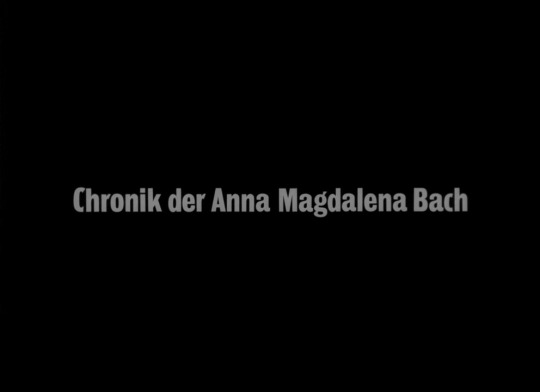
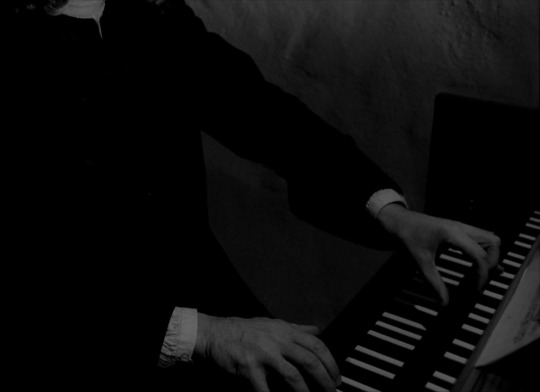
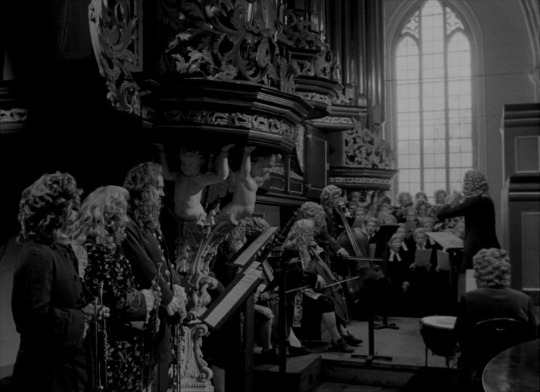


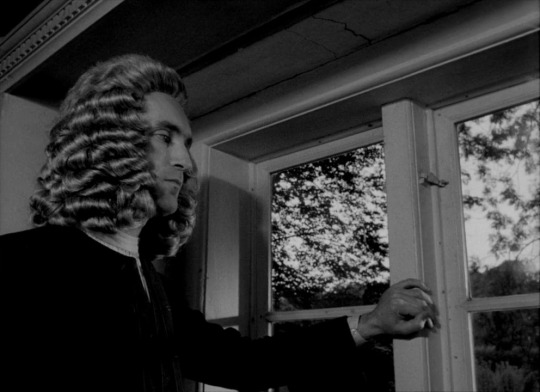
Chronicle of Anna Magdalena Bach [Chronik der Anna Magdalena Bach] (1968), dir. Jean-Marie Straub, Danièle Huillet
#chronicle of anna magdalena bach#chronik der anna magdalena bach#jean-marie straub#daniele huillet#german cinema#film stills#*#directed by women
12 notes
·
View notes
Note
The Chronicle of Anna Magdalena Bach (1968)
I haven't seen that! Tell me a bit about it I might wanna watch it
2 notes
·
View notes
Text
How did Jean Marie Straub die? Cause of death - revealed.


How did Jean Marie Straub die? Cause of death - revealed
How did Jean Marie Straub die? Cause of death - revealed.Let’s look at what happened and Jean Marie Straub cause of death in more depth.
Who is Jean Marie Straub?
French filmmakers Jean-Marie Straub and Danièle Huillet collaborated on a dozen movies between 1963 and 2006.
Their films are renowned for their radical, communist politics and rigorous, intellectually challenging aesthetic.
Despite being French, they both primarily worked in Germany and Italy. Among the best-received works by the team are Sicilia! (1999) and From the Clouds to the Resistance (1979).
Jean Marie Straub career
In 1954, Metz-born Straub and Paris-born Huillet met while they were both students. At the time, Straub was active in the Parisian film world.
Francois Truffaut and Straub were friends, and Straub contributed to Cahiers du Cinéma, albeit Truffaut would not publish some of Straub's more provocative works.
] He served as Jacques Rivette's assistant while he was directing the 1956 movie A Fool's Mate.
He also supported Abel Gance, Jean Renoir, Robert Bresson, and Alexandre Astruc in their work in Paris.
Later, the two moved to Germany so that Straub could avoid serving in the Algerian military. During his early years, Straub studied Bach.
Huillet initially intended to produce ethnographic films, but she ended up working with Straub on his endeavours instead.
After 1968's Chronicle of Anna Magdalena Bach, they made movies at a comparatively steady pace, finishing a feature every two to three years. Prior to that, they had not made a full-length feature.
The Chronicle of Anna Magdalena Bach was laboriously produced. Up until 1967, there was a ten-year financial battle.
They also produced a short film in 1968 called The Bridegroom, the Actress, and the Pimp, which starred Rainer Werner Fassbinder and his theatre group. ] Midway through the 1970s, they started making movies in Italy.
They increasingly started dividing their time between Italy and Germany and frequently worked with French and British producers. ]For the most of their lives, Straub and Huillet were housemates. They didn't have any kids.
Jean Marie Straub-Cause of death.
There is no information available about Jean Marie Straub cause of death at the moment.
MPM news have been trying to reach out to the family and relatives for comment on the incident. So far no responses have been received.
We will update the page once enough information is available.
More information on Jean Marie Straub cause of death will be added soon.
Jean Marie Straub collaboration .
Jean-Marie Straub represented the couple in public since he is more outgoing; this has led to the general perception that Huillet had a supporting role in their filming. In actuality, the two divided their work evenly, with Huillet in charge of the majority of production design and editing, Straub handling the mise en scène, and the two sharing equal responsibility for pre-production, texts, and rehearsals.
This technique is demonstrated in Pedro Costa's documentary Where Does Your Hidden Smile Lie?, which was shot while Sicilia! was being edited.
The longevity of Huillet and Straub's relationships with many of their employees—often lasting for decades—is what makes their work unique.
The majority of their work was produced by two cameramen, William Lubtchansky (9 pictures) and Renato Berta (20 films as of this writing), both of whom Jean-Marie Straub continues to collaborate with.
Between 1967 and 1998, Louis Hochet, a sound engineer, was in charge of the sound recordings for 15 of her movies, including Chronik der Anna Magdalena Bach (1967), Moses and Aron (1974), and Von heute, which is determined by live recorded music auf Morgen (1996), all of which pioneered the use of music in motion pictures.
A similarly influential relationship also existed with the Tuscan village of Buti, which was mostly employed asThe filmmakers Peter Nestler, Frans van de Staak, Holger Meins, Jean-Luc Godard, as well as their longtime cameraman Renato Berta, were just a few of the friends and coworkers Huillet and Straub frequently paid respect to.
In contrast, Straub and Huillet were more frequently the focus of other people's films.
Films about his and her work have been produced by Harun Farocki (Amerika, a 1983 movie based on a story by Franz Kafka, starring Jean-Marie Straub and Danièle Huillet), Pedro Costa (Where Does Your Hidden Smile Lie?, 2001), and Peter Nestler (Defense of Time, 2007).
Also read: How did Patrick Torrey die? Beck’s basketball player’s cause of death revealed
Read the full article
#CauseofdeathrevealedMarieStraub#HowdidJeanMarieStraubdie#HowdidJeanMarieStraubdied#HowdidMarieStraubdied#JeanMarie#JeanMarieStraub#JeanMarieStraubachievement#JeanMarieStraubage#JeanMarieStraubbiography#JeanMarieStraubcareer#JeanMarieStraubcauseofdeath#JeanMarieStraubdie#JeanMarieStraubdied#JeanMarieStraubimage#JeanMarieStraubpassedaway#JeanMarieStraubphotos#JeanMarieStraubwiki#JeanMarieStraubWikipedia#MarieStraub#MarieStraubcauseofdeath#WhathappenedtoJeanMarieStraub#WhoisJeanMarieStraub
0 notes
Photo
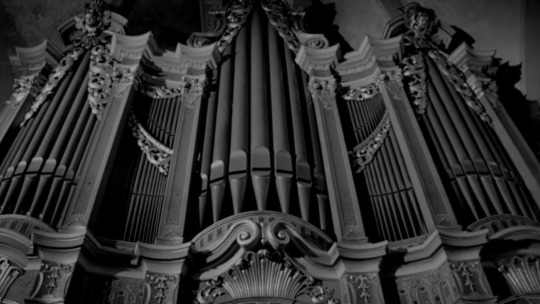
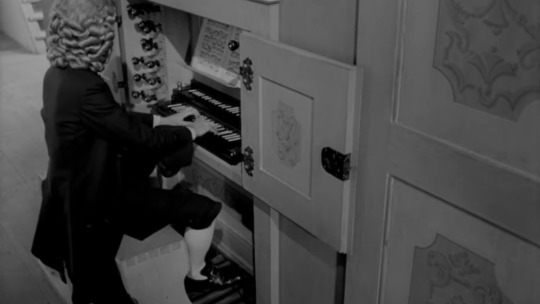
The Chronicle of Anna Magdalena Bach (1968) - Jean-Marie Straub and Danièle Huillet
6 notes
·
View notes
Photo

Seen in 2019:
The Chronicle of Anna Magdalena Bach (Daniele Huillet & Jean-Marie Straub), 1968
#films#movies#stills#music#The Chronicle of Anna Magdalena Bach#Baroque#Daniele Huillet#Jean-Marie Straub#women directors#1960s#seen in 2019#Mubi
12 notes
·
View notes
Photo

Film du Jour: The Chronicle of Anna Magdalena Bach - 1968 - Jean-Marie Straub & Danièle Huillet
2 notes
·
View notes
Photo
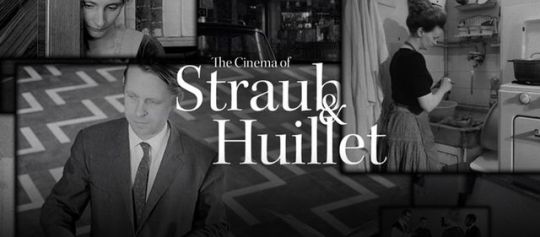
Classifying the Films of Jean-Marie Straub and Daniele Huillet by Stuart Collier
The films of Jean-Marie Straub and Daniele Huillet — it is said time and time again — are challenging, rigorous, alienating, invariably belonging to a mode of filmmaking that uses cinema as a means of accessing the Western cultural past. Jean-Luc Godard, Pier Paolo Pasolini, Derek Jarman, among many others, have similarly sought to filter ancient texts through the medium of cinema, and, in the process, to creatively resolve those heated junctures where antiquity and modernity don’t quite mesh together. Yet Straub and Huillet’s commitment to this demanding, dialectical approach to filmic storytelling was uniquely all-consuming: with very few exceptions, each of their feature films tackles an exceptionally ambitious source, be it Franz Kafka or Sophocles, and pushes the art of adaptation to new experimental heights.
Now, this is not to say that these films are inaccessible, deified works of art more fitting for the museum or the lecture hall than the home media center. I would like to cast this duo’s films in a less demanding light. For all of the textual interpolations and formal rigor of these films, they are far from confusing — rather, the subject matter of each film is approached with a directness uncommon in most narrative cinema. In fact, I would even propose that they can be classified according to genre, and that these recognizable forms of storytelling can help us to understand what makes Straub and Huillet so unique.
The Musician Biopic
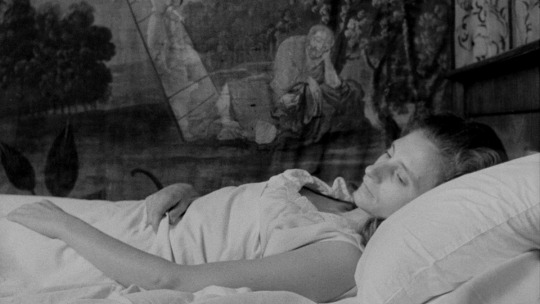
THE CHRONICLE OF ANNA MAGDALENA BACH (’68) remains Straub and Huillet’s most celebrated work, precisely because it has no interest in adhering to the dictates of dramatic storytelling. This is a truly uncompromising biopic in that it recreates Johann Sebastian Bach’s actual music without adding on any bells or whistles. Bach himself is played by Dutch harpsichordist and organist Gustav Leonhardt, who facilitates over two dozen performances of the master’s pieces throughout the film, all of which are rendered with an uncanny verisimilitude in many of the original locations where Bach actually performed. As for narrative, conflict or characterization — these qualities are all cryptically embedded in the fictitious diary entries of his second wife, Anna Magdalena (played by Christiane Lang-Drewanz), which are read in intervals between performances. Where a traditional biopic might work to dramatically emphasize the contradictions between the music and the man, Straub and Huillet present the two side-by-side, in alternating blocks of screen time, beseeching the audience to thread the needle of this biographical history for themselves.
The Political Thriller

In 1664, French tragedian Pierre Corneille’s play Othon was staged at the court of King Louis XIV. This obscure drama, practically unknown today, concerns the labyrinthine bids for imperial power following the death of Emperor Nero. Straub and Huillet, for their first color film, decided to adapt this long forgotten relic of the West’s theatrical heritage, opting for the rather unusual title, EYES DO NOT WANT TO CLOSE AT ALL TIMES… (’70). Shot on location on the Palatine Hill of Rome, with all actors in period dress, the film is notable for one striking and deliberate inconsistency: Straub and Huillet make no effort to camouflage Rome as it exists today, replete with automotive traffic in the background and the din of urban industry riddling the soundtrack. As a panoply of characters engages in consultation and conspiracy regarding the fate of Rome — not all of it entirely comprehensible — the filmmakers continually emphasize that the Rome under discussion is a living historical paradox. This is not a political thriller in the vein of Alan J. Pakula — there is little action or suspense, for starters — but Straub and Huillet are no less interested in the nested intricacies of political power.
The Biblical Epic

In the early 1930s, Arnold Schoenberg wrote a three-act opera based on the Book of Exodus, particularly those passages involving Moses and his brother Aaron in dialogue with the Israelites, who are not yet convinced that Moses is God’s chosen prophet. In 1973, Straub and Huillet translated this unconventional and unfinished work (the music for the third act was never completed in Schoenberg’s lifetime) to the screen, and did so with aplomb. Even if the opera is hard to take, the events of MOSES AND AARON (’75) unfold with a Sunday School simplicity – the burning bush, the serpentine staff, the golden calf are all recreated in the naturally arid desert arenas of Egypt and Italy. In terms of spectacle, it’s a far cry from Cecil B. DeMille — much too minimalistic for that — but the duo’s approach to framing and camera movement intensifies the action. I can’t think of a better film for capturing the pendular swings of Old Testament rhetoric, as it is played out in the perennial conflict between the Almighty and His chosen people, fickle to the last. Be sure to read more about Straub and Huillet here.
#FilmStruck#Jean-Marie Straub#Danièle Huillet#The Chronicle of Anna Magdalena Bach#Eyes Do Not Want to Close at All Times#Eyes Do Not Want to Close at All Times or Perhaps One Day Rome Will Permit Herself to Choose in Her Turn#Othon#Moses And Aaron#StreamLine Blog#Stuart Collier
15 notes
·
View notes
Photo
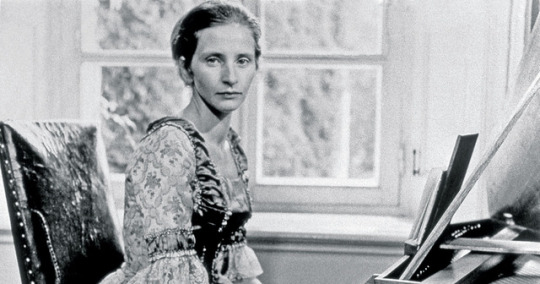
Parsing the embarrassment of riches amongst ’60s French cinema, the annals of Official Film History tends to split us into the New Wave (Godard, Rivette, Rohmer, etc.), the left-bank (Chris Marker, Alain Resnais, Agnès Varda), and the successive “ Second New Wave” (Maurice Pialat, Jean Eustache, Luc Moullet). Bouncing between realism and the avant-garde, these filmmakers, to varying degrees of mainstream acceptance, left an undeniable mark on post-war art cinema. Yet provided you’re hip enough to know, there’s two particular names that seem to instantly dwarf the aforementioned, at least in the terms of uncompromised Film Art: the husband-wife duo of Jean-Marie Straub & Danièle Huillet — or, if you prefer, the synthesized, punchier Straub/Huillet.
The mystique that has emerged around this duo is not just due to the general unavailability of their work — to this day, only one of their films are available on Region 1 DVD — but in the almost-comical levels of difficulty that seem to surround them. Take, for example, the niche cinephile torrent site Karagarga, where enigmatic critic Tag Gallagher has taken to lamenting the subtitle files that accompany downloads for their films, to the point of sharing his own home-made, supposedly correct editions. This is to keep in mind that the two have openly stated that if you weren’t fluent in the native language of one of their films (be it Italian or German), you’d be at a total loss even with subtitles. The additional “homework” required by the viewer is familiarity with the source material, be it by Bertol Brecht, Friedrich Hölderlin, or Arnold Schoenberg. Their films ask you to reach beyond the cinematic and into history, literature, poetry, or opera.
Exploring the pleasure principle of a Straub/Huillet classic, The Chronicle of Anna Magdalena Bach, part of a new Toronto retrospective.
22 notes
·
View notes
Photo
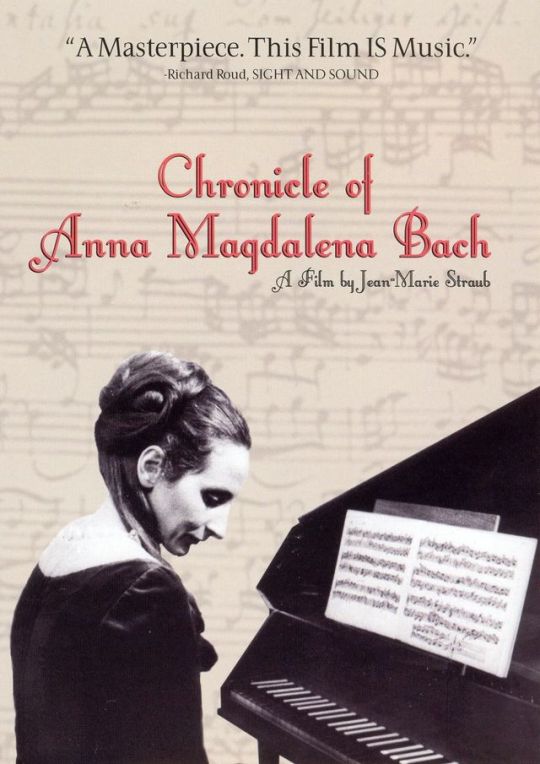
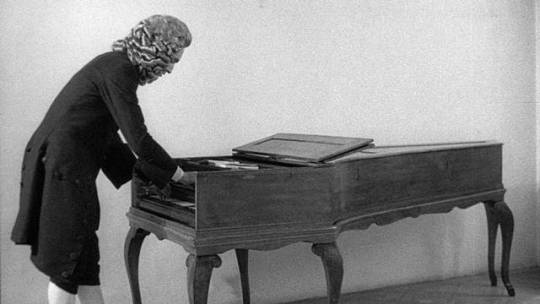
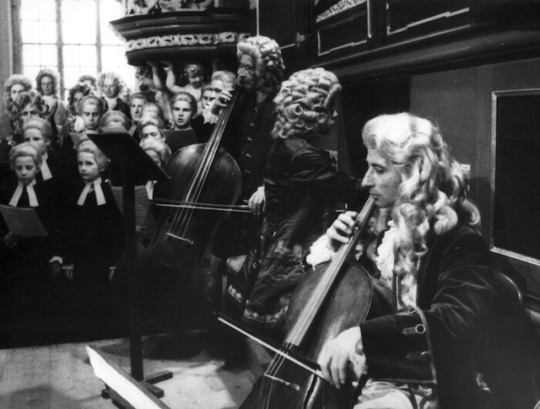

Chronicle of Anna Magdalena Bach (1968) is ranked number 713 on the TSPDT list of the 1,000 Greatest Films. This biography of Johann Sebastian Bach narrated by his wife Anna consists mostly of static scenes of Bach conducting and/or playing his compositions. The actor who played him never acted before or after. He is a music scholar on the works of Bach, whose own recordings as conductor and harpsichord player are exemplary. I am curious to eventually see this TSPDT entry.
The film was co-directed by Daniele Huillet and Jean-Marie Straub. They were both born in France, Daniele had 28 credits from a 1963 short, this, her first feature, to an uncredited 2006 tv short. Jean-Marie has 52 director credits, from a 1963 short to a 2018 short. Most of his credits are for documentaries and shorts.
They have four other films on the TSPDT list: Sicilia (835), Not Reconciled (882), Too Early Too Late (928), and From the Clouds to the Resistance (971). I have not seen any of their films.
2 notes
·
View notes
Photo
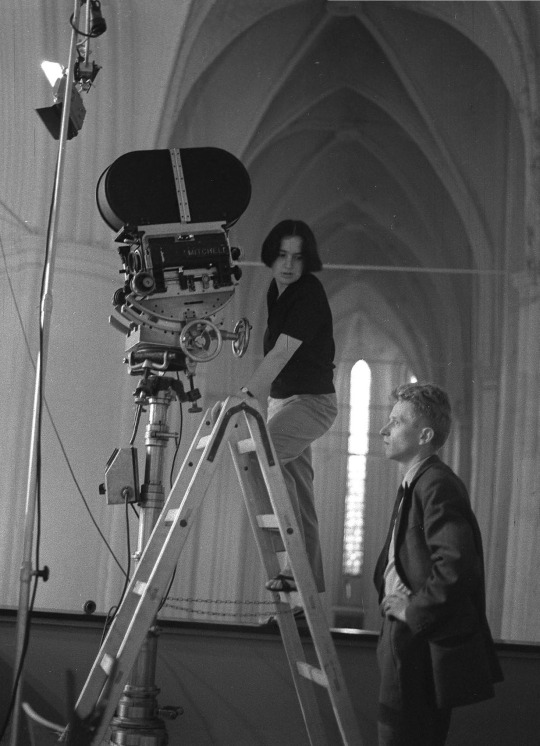
Danièle Huillet and Jean-Marie Straub on the shoot of Chronicle of Anna-Magdalena Bach, 1967. © Heiner Roß Collection / Estate of Joachim Wolf (Kinemathek Hamburg) at Munich Film Museum and BELVA Film GmbH.
source
56 notes
·
View notes
Photo

The Chronicle of Anna Magdalena Bach (Danièle Huillet & Jean-Marie Straub, 1968)
9 notes
·
View notes
Photo

Chronik der Anna Magdalena Bach [The Chronicle of Anna Magdalena Bach] (1968) Jean-Marie Straub and Danièle Huillet
https://www.youtube.com/watch?v=usc4LNFL5e4
2 notes
·
View notes
Photo
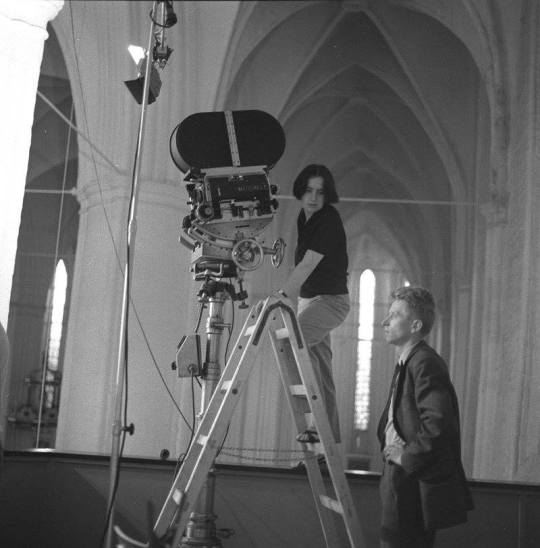
Happy 87th, Jean-Marie Straub.
With Danièle Huillet on the set of The Chronicle of Anna Magdalena Bach (1968).
25 notes
·
View notes
Text
top 10 movies watched for the first time in MAY 2019
1. Salo, or the 120 Days of Sodom (1975, Pier Paolo Pasolini)
2. Funeral Parade of Roses (1969, Toshio Matsumoto)
3. Perfect Blue (1997, Satoshi Kon)
4. The Beaches of Agnès (2008, Agnès Varda)
5. River of Grass (1994, Kelly Reichardt)
6. Her Smell (2001, Alex Ross Perry)
7. Brief Crossing (2001, Catherine Breillat)
8. Machorka-Muff (1963, Jean-Marie Straub & Danièle Huillet)
9. Chronicle of Anna Magdalena Bach (1968, Jean-Marie Straub & Danièle Huillet)
10. Goodbye to Language (2014, Jean-Luc Godard)
#month#top 10#salo#pier paolo pasolini#funeral parade of roses#toshio matsumoto#perfect blue#satoshi kon#the beaches of agnès#agnès varda#river of grass#kelly reichardt#her smell#alex ross perry#brief crossing#catherine breillat#jean marie straub#danièle huillet#goodbye to language#Jean Luc Godard
55 notes
·
View notes
Note
what are your favorite movies? I love your blog
Zerkalo, Stalker, Andrei Rublev, Nostalgia, Solaris, Sansho the Bailiff, Osaka Elegy, The Story of the Last Chrysanthemums, When A Woman Ascends The Stairs, Le Notti di Cabiria, Sans Soleil, The Red Shoes, The Third Man, 8½, Late Spring, Floating Weeds, High And Low, The Bad Sleep Well, Le Plaisir, Autumn Sonata, Winter Light, The Virgin Spring, Cries and Whispers, Hour of the Wolf, Au Hasard Balthazar, Les cousins, Le feu follet, Vivre sa vie, Yi yi, A Time To Live/A Time to Die, The Last Year at Marienbad, Les statues meurent aussi, The Fallen Idol, L'Atalante, Woman in the Dunes, Sunrise: A Song of Two Humans, The Chronicle of Anna Magdalena Bach, All About Eve, Dark Victory, Greed, Napoléon vu par Abel Gance, The Face of Another, Babette’s Feast, Journal d'un curé de campagne, Ordet, Vampyr, Gertrud, Les Demoiselles de Rochefort, Werckmeister Harmonies, The Ghost and Mrs. Muir, Broken Blossoms, Diary of a Lost Girl, The Heiress, Ascenceur pour L'Echafaud, The Life and Death of Colonel Blimp, The Promised Country, La Rayon Vert, Opening Night, Faces, Love Streams, Harakiri, Léon Morin, prêtre, Les Dames du Bois de Boulogne, Orphée, Le testament d'Orphée, La Belle Noiseuse, Dr. Mabuse, der spieler, The Human Condition (I, II, III), 24 Frames, Letter from an Unknown Woman, Till We Meet Again (Borzage), Rebecca, La Notte, Jules et Jim, Tie Xi Qu: West of the Tracks, Ikiru, Akahige, Ivan Grozny (I, II), Un condamné a mort s'est échappé, The Trial, F for Fake, Trois couleurs: Bleu, Trois couleurs: Rouge, The Wind, Bob Le Flambeur, La peau douce, L'Histoire d'Adele H., La Grande Illusion, La maman et la putain, I Know Where I’m Going!, Faust (Murnau), Medea, Mamma Roma, The House is Black, The Bitter Tears of Petra von Kant, Sonatine, The Ballad of Narayama, Roma città aperta, Voyage to Italy, The Roaring Twenties, Baby Face, Design for Living, Vivre sa Vie, Brief Encounter, The Circus, City Lights, The Night of the Hunter, Monsieur Verdoux, Terje Vigen, The Cabinet of Dr. Caligari, From Morn to Midnight, The Lady Vanishes, Kuroneko, Play Time, Le Quai des Brumes, Apur Sansar, The Music Room, In the Mood for Love, Taste of Cherry, Through the Olive Trees, Viridiana, Tale of Tales, To Be Or Not To Be, Sherlock Jr., Our Hospitality, The General, The Apartment, Pandora’s Box, Veronika Voss, Morocco, L'Age d'Or, The Passion of Joan of Arc, Laura, Where The Sidewalk Ends, Notorious, The 39 Steps, The Big Sleep, In A Lonely Place, Easy Living, The Thin Man, The Shop Around The Corner, Knight Without Armour, As I Was Moving Ahead Occasionally I Saw Brief Glimpses of Beauty, Steamboat Bill Jr., Floating Clouds, Umberto D., Throne of Blood, Yojimbo, The Big Heat, Chronicle of a Summer, A Streetcar Named Desire, The Lost Weekend, La Ronde, Der amerikanische Freund, The Smiling Lieutenant, The Uninvited, Wings (Shepitko), The Ascent, Come and See, Liebelei, Ran, Le Fantôme de la liberté, The Color of Pomegranates, Les Vampires, Dr. Strangelove, Certified Copy, The Nibelung: Siegfried, Shadows of our Forgotten Ancestors, Devi, The Phantom Carriage, Russian Ark, and many, many others.
514 notes
·
View notes
Photo
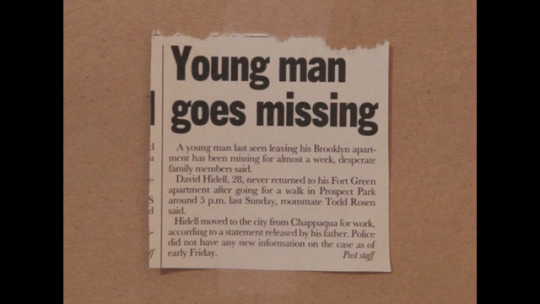


I’ve been interested in the work of Ricky D’Ambrose since watching his interviews, teasers for his shorts and writings on his micro-budget approach to making films. Although I’ve yet to see any of his narrative work, I had no hesitation to support him when I heard he was making a feature, which looks to be something of a detective story via selective information produced from newsclippings, maps and journal entries.
You can support Ricky D’Ambrose kickstarter campaign for ‘Notes on an Appearance’ here
Influences for his film include: News from Home (Chantal Akerman), Muriel (Alain Resnais), The Chronicle of Anna Magdalena Bach (Jean-Marie Straub and Danièle Huillet), The Devil, Probably (Robert Bresson)
13 notes
·
View notes